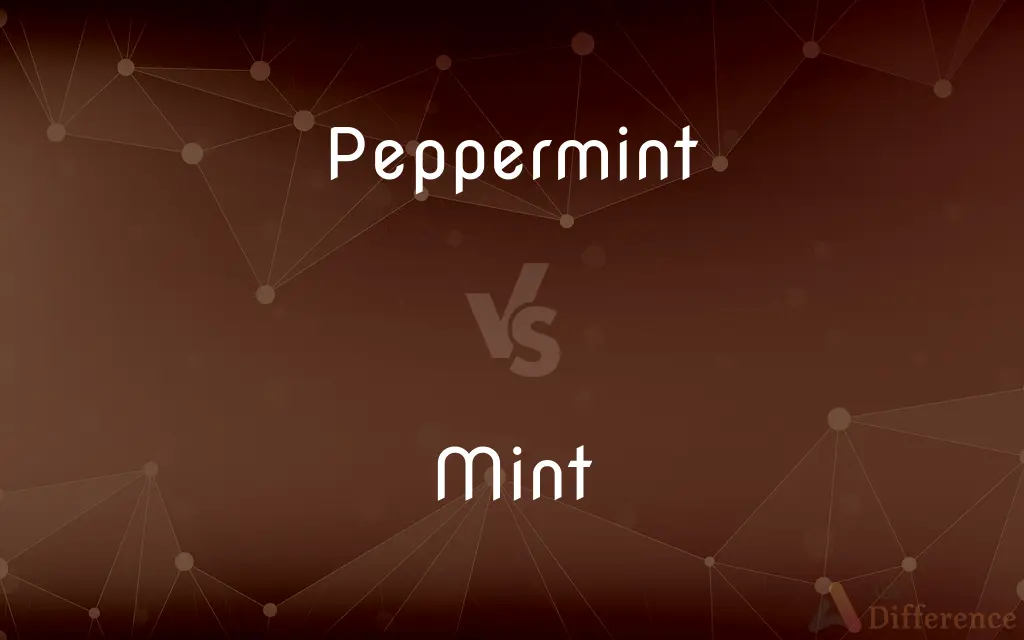Peppermint vs. Mint — What's the Difference?
By Fiza Rafique & Maham Liaqat — Updated on April 14, 2024
"Peppermint" is a specific hybrid mint variety, known for its strong flavor and cooling effects, while "mint" refers to a broader family of aromatic plants with various culinary and medicinal uses.

Difference Between Peppermint and Mint
Table of Contents
ADVERTISEMENT
Key Differences
Peppermint is a specific type of mint, scientifically known as Mentha piperita, characterized by its sharp, peppery flavor. Mint, on the other hand, refers to the entire genus Mentha, which includes many different species with varying flavors and uses.
In culinary contexts, peppermint is commonly used in candies, toothpastes, and medicinal products due to its strong, refreshing taste and cooling sensation. Whereas mint in general, may refer to a variety of species like spearmint or apple mint, each contributing differently to dishes ranging from teas to sauces.
The oil extracted from peppermint leaves contains high levels of menthol, making it particularly potent and beneficial for digestive and respiratory health. Mint oils in general, while also containing menthol, may have lower concentrations and differ in composition depending on the species.
Peppermint plants are typically taller and have darker, more vibrant green leaves compared to some other mint species. In contrast, mint plants can vary widely in appearance, from the hairy leaves of apple mint to the smoother, lighter green leaves of spearmint.
Gardeners often prefer peppermint for its relatively controlled growth and ability to thrive in various climates, while mint, especially spearmint, can be more invasive, quickly overtaking garden spaces if not properly managed.
ADVERTISEMENT
Comparison Chart
Scientific Name
Mentha piperita
Mentha (various species)
Flavor Profile
Strong, sharp, and cooling with high menthol content.
Varies, generally milder than peppermint.
Common Uses
Medicinal products, toothpaste, candies.
Culinary dishes, teas, decorations.
Leaf Appearance
Dark green, pointed leaves.
Varies widely among species.
Plant Characteristics
Typically controlled growth, taller plants.
Can be invasive, varies in size and form.
Compare with Definitions
Peppermint
A decorative plant with vibrant green leaves.
Peppermint plants add both color and fragrance to gardens.
Mint
A herbal remedy with various health benefits.
Mint leaves are used in traditional medicine for their soothing effects.
Peppermint
A candy flavor derived from peppermint oil.
Peppermint candies are popular during the holiday season.
Mint
A common garden plant that can be both ornamental and invasive.
Mint requires careful placement in gardens due to its fast growth.
Peppermint
A scent commonly found in cleaning products.
Many natural cleaning products use peppermint for its refreshing scent.
Mint
A genus of plants known for their aromatic leaves.
Mint leaves are often used to add flavor to drinks and dishes.
Peppermint
A natural remedy for digestive issues.
Peppermint tea is consumed as a digestive aid.
Mint
A flavoring used in a variety of products from gum to sauces.
Mint is a versatile flavor used in both sweet and savory recipes.
Peppermint
A hybrid mint plant known for its strong, cooling flavor.
Peppermint oil is often used in aromatherapy for its soothing properties.
Mint
A term used in finance to denote the production of money.
The U.S. Mint is responsible for producing coinage.
Peppermint
Peppermint (Mentha × piperita, also known as Mentha balsamea Wild) is a hybrid mint, a cross between watermint and spearmint. Indigenous to Europe and the Middle East, the plant is now widely spread and cultivated in many regions of the world.
Mint
A place where the coins of a country are manufactured by authority of the government.
Peppermint
A hybrid perennial plant (Mentha ×piperita) in the mint family, having small purple or white flowers and downy leaves that yield a pungent oil used as a flavoring and in some medicinal preparations.
Mint
A place or source of manufacture or invention.
Peppermint
A candy or lozenge flavored with oil from this plant.
Mint
An abundant amount, especially of money.
Peppermint
A hybrid herb of the mint family (Mentha × piperita), formed by crossing watermint and spearmint, which has a high menthol content and a sharp flavor and is used in cooking, especially in herb teas and in confections.
Mint
A member of the mint family.
Peppermint
(countable) A confection containing extract of peppermint.
Mint
Any of various rhizomatous plants of the genus Mentha of the mint family, characteristically having nearly regular white or purple flowers. Some species are cultivated for their aromatic oil and foliage.
Peppermint
An aromatic and pungent plant of the genus Mentha (Mentha piperita), much used in medicine and confectionery.
Mint
The leaves of some of these plants, used as a seasoning.
Peppermint
A volatile oil (oil of peppermint) distilled from the fresh herb; also, a well-known essence or spirit (essence of peppermint) obtained from it.
Mint
Any of various similar or related plants, such as the stone mint.
Peppermint
A lozenge of sugar flavored with peppermint.
Mint
A candy flavored with natural or artificial mint flavoring.
Peppermint
Herb with downy leaves and small purple or white flowers that yields a pungent oil used as a flavoring
Mint
To produce (money) by stamping metal; coin.
Peppermint
Red gum tree of Tasmania
Mint
To invent or fabricate
A phrase that was minted for one occasion.
Peppermint
A candy flavored with peppermint oil
Mint
Undamaged as if freshly minted
The painting was in mint condition.
Mint
A building or institution where money (originally, only coins) is produced under government licence.
Mint
(informal) A vast sum of money; (by extension) a large amount of something.
That house is worth a mint.
It must have cost a mint to produce!
To make a mint
Mint
(figuratively) Any place regarded as a source of unlimited supply; the supply itself.
Mint
Any plant in the genus Mentha in the family Lamiaceae, typically aromatic with square stems.
Mint
The flavouring of the plant, either a sweet, a jelly or sauce.
Mint
Any plant in the mint family, Lamiaceae.
Mint
A green colour, like that of mint.
Mint
A mint-flavored candy, often eaten to sweeten the smell of the breath.
Mint
Intent, purpose; an attempt, try; effort, endeavor.
Mint
(transitive) To reproduce (coins), usually en masse, under licence.
Mint
To invent; to forge; to fabricate; to fashion.
Mint
To create a crypto token.
Mint
To try, attempt; take aim.
Mint
To try, attempt, endeavor; to take aim at; to try to hit; to purpose.
Mint
To hint; suggest; insinuate.
Mint
(with condition) Like new.
In mint condition
Mint
In near-perfect condition; uncirculated.
Mint
(philately) Unused with original gum; as issued originally.
Mint
Very good.
Mint
Attractive; beautiful; handsome.
Mint
Of a green colour, like that of the mint plant.
Mint
The name of several aromatic labiate plants, mostly of the genus Mentha, yielding odoriferous essential oils by distillation. See Mentha.
Mint
A place where money is coined by public authority.
Mint
Any place regarded as a source of unlimited supply; the supply itself.
A mint of phrases in his brain.
Mint
A large quantity of money; as, to make a mint in stock trading.
Mint
To make by stamping, as money; to coin; to make and stamp into money.
Mint
To invent; to forge; to fabricate; to fashion.
Titles . . . of such natures as may be easily minted.
Mint
Like new; in brand-new condition; unworn, as a coin recently made at a mint{1}; as, he had a '53 Cadillac in mint condition.
Mint
Uncirculated; in the same condition as when it was freshly coined at the mint{1}.
Mint
(often followed by `of') a large number or amount or extent;
A batch of letters
A deal of trouble
A lot of money
He made a mint on the stock market
It must have cost plenty
Mint
Any north temperate plant of the genus Mentha with aromatic leaves and small mauve flowers
Mint
The leaves of a mint plant used fresh or candied
Mint
A candy that is flavored with a mint oil
Mint
A plant where money is coined by authority of the government
Mint
Form by stamping, punching, or printing;
Strike coins
Strike a medal
Mint
As if new;
In mint condition
Common Curiosities
Is peppermint better than other mints for medicinal purposes?
Peppermint is often preferred for medicinal uses, especially for digestive and respiratory conditions, due to its high menthol concentration.
What distinguishes peppermint from other mints?
Peppermint is specifically known for its high menthol content and strong flavor.
What are the benefits of drinking mint tea?
Mint tea aids in digestion, relieves stress, and provides a calming effect.
Can peppermint oil help with headaches?
Yes, peppermint oil is often used topically to relieve tension headaches.
Can you use any mint for making mojitos?
While any mint can technically be used, spearmint is traditionally preferred for its milder flavor compared to peppermint.
How does mint flavor vary among different species?
Mint flavors can range from strongly mentholated in peppermint to sweet and mild in apple mint.
Why is peppermint popular in toothpaste?
Peppermint's strong, refreshing taste and antibacterial properties make it ideal for oral hygiene products.
What are the aesthetic benefits of growing peppermint in a garden?
Peppermint adds both visual appeal and a pleasant scent to gardens.
Can mint be harmful to pets?
Some mint species can be toxic to pets, so it's important to check which varieties are safe.
How do you manage mint in a garden?
Mint, especially varieties like spearmint, can be invasive; it's best to grow it in containers to control its spread.
Are there any risks to consuming peppermint?
Peppermint is generally safe, though it can cause heartburn or allergic reactions in some individuals.
What makes mint a common ingredient in culinary dishes?
Mint adds a fresh, aromatic flavor to both savory and sweet dishes.
How does mint affect digestion?
Mint promotes digestion by soothing the stomach muscles and improving bile flow.
What is the historical significance of mint?
Mint has been used since ancient times for its medicinal properties and as a culinary herb.
What's the best way to store mint leaves?
Fresh mint leaves should be stored in the refrigerator, wrapped in a damp paper towel and placed in a plastic bag.
Share Your Discovery

Previous Comparison
Disease vs. Illness
Next Comparison
Wholesaler vs. DistributorAuthor Spotlight
Written by
Fiza RafiqueFiza Rafique is a skilled content writer at AskDifference.com, where she meticulously refines and enhances written pieces. Drawing from her vast editorial expertise, Fiza ensures clarity, accuracy, and precision in every article. Passionate about language, she continually seeks to elevate the quality of content for readers worldwide.
Co-written by
Maham Liaqat














































